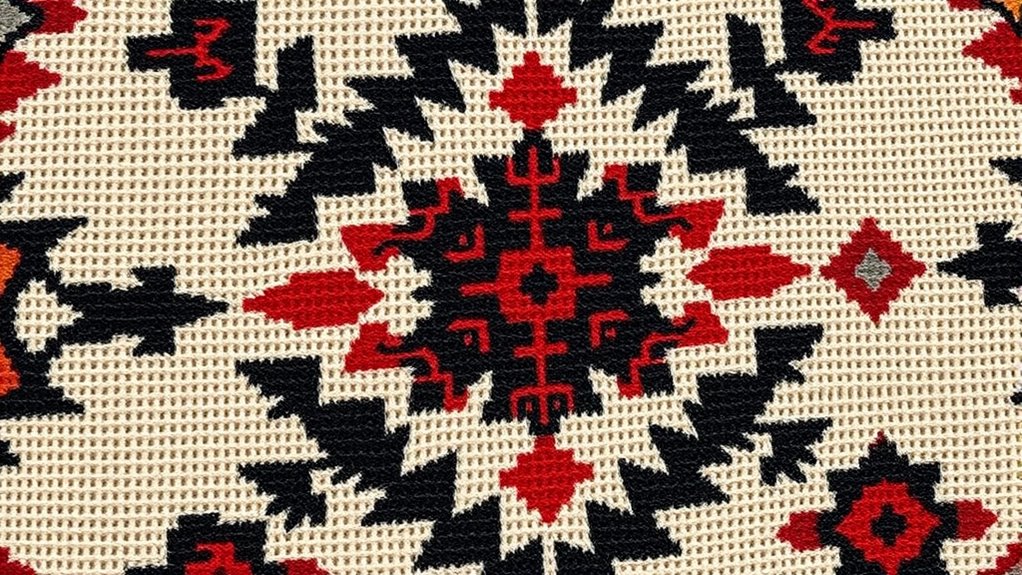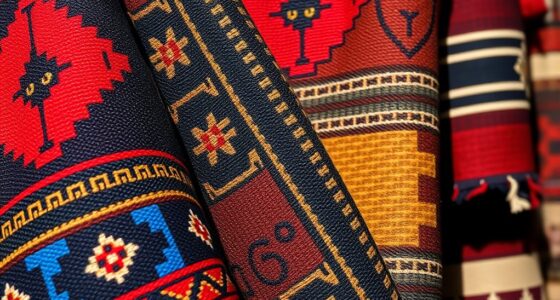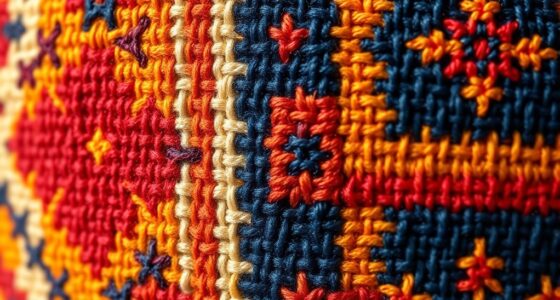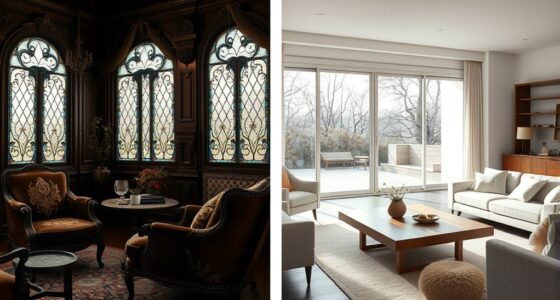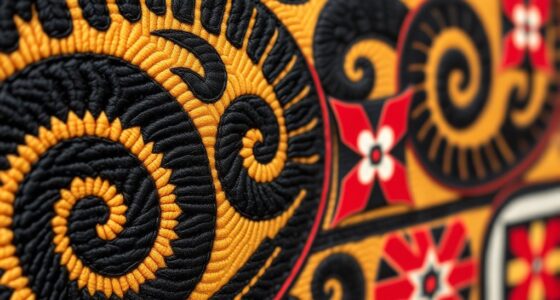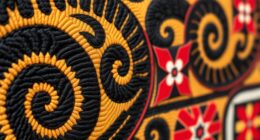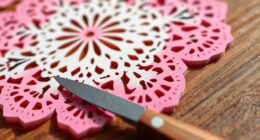You’ll find that tribal patterns in boho art serve as a connection to cultural origins, symbolizing identity, beliefs, and heritage. These motifs add depth by telling stories and carrying spiritual significance, making your decor more meaningful. Artists incorporate traditional techniques and bold geometric designs, blending authenticity with modern styles. As tribal influences evolve, they shape contemporary boho aesthetics, offering timeless appeal. To explore how these patterns continue to inspire, keep exploring the rich world of tribal boho art.
Key Takeaways
- Tribal patterns serve as foundational elements in boho art, symbolizing cultural identity and storytelling.
- They incorporate geometric motifs and earthy colors to evoke natural and spiritual themes in boho designs.
- Tribal patterns in boho art reflect cultural heritage, adding authenticity and depth to aesthetic compositions.
- The use of traditional textile techniques enhances texture and craftsmanship within boho artistic expressions.
- Integrating tribal motifs promotes cultural appreciation and preserves indigenous symbolism in modern boho decor.
The Origins of Tribal Patterns in Art and Culture
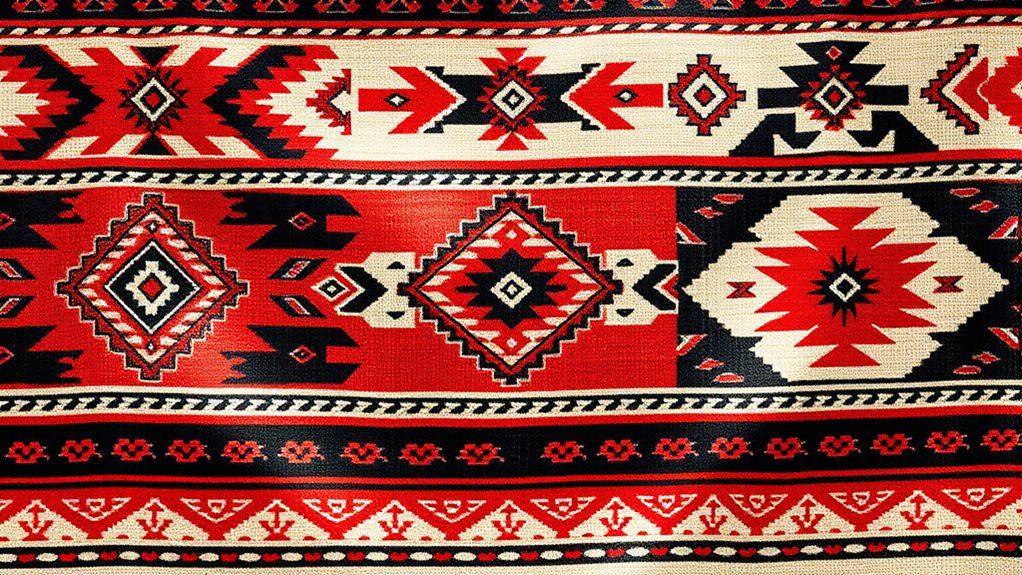
Tribal patterns in art and culture originate from the symbolic expressions of indigenous communities, serving as visual language that conveys identity, beliefs, and social connections. These patterns are deeply rooted in tribal fashion, where clothing and accessories feature specific motifs that signify status, lineage, or spiritual beliefs. Through tribal storytelling, these designs pass down traditions and histories, allowing communities to preserve their heritage visually. When you explore tribal patterns, you’re engaging with a rich history of visual communication that goes beyond aesthetics. Each pattern tells a story, representing ancestral knowledge and cultural values. This connection between art and tradition makes tribal patterns a powerful element in contemporary boho fashion and design, blending history with modern expression. Additionally, these patterns often reflect the community’s cultural diversity, illustrating the variety of styles and meanings across different tribes and regions.
Symbolism and Meaning Behind Tribal Motifs
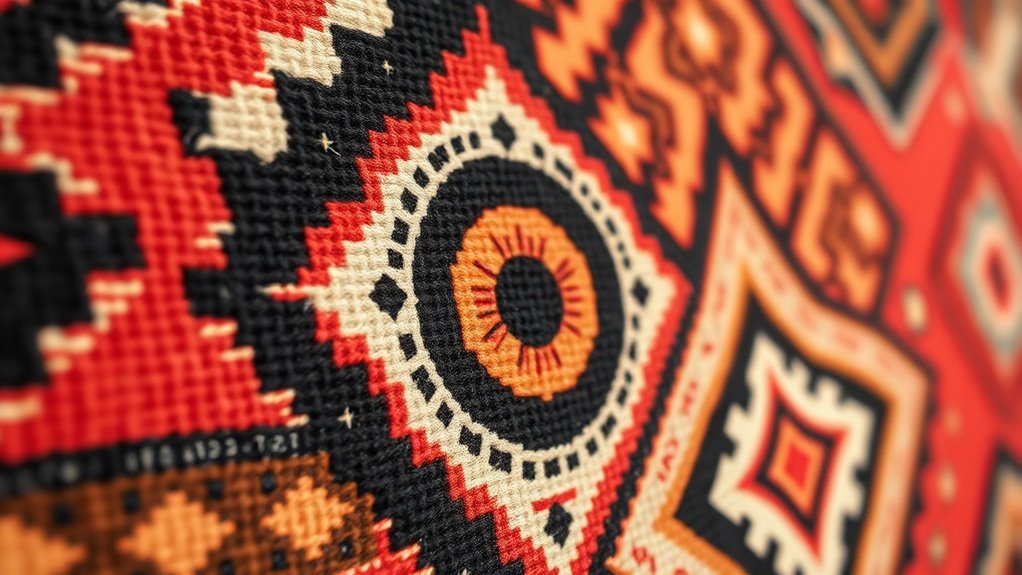
You’ll notice that tribal motifs often carry deep cultural heritage, reflecting the history and identity of their communities. These patterns are used in rituals and spiritual practices, symbolizing beliefs and sacred traditions. Understanding the meanings behind these symbols helps you appreciate their significance beyond mere decoration. For example, many patterns incorporate symbolism and meaning behind tribal motifs, which serve as visual expressions of cultural stories and values.
Cultural Heritage Significance
Many tribal patterns carry deep symbolic meanings that reflect their communities’ beliefs, history, and values. These motifs are often embedded in tribal fashion and jewelry, serving as expressions of cultural identity. When you wear tribal jewelry, you connect with centuries-old traditions that symbolize status, protection, or spiritual beliefs. Understanding these symbols helps you appreciate their cultural heritage. Here are three key points:
- Tribal patterns often convey social status and community roles.
- They serve as visual storytelling, preserving history and legends.
- Incorporating tribal motifs in fashion honors ancestral craftsmanship.
- Recognizing the symbolic significance of patterns deepens your cultural appreciation.
Ritual and Spiritual Use
Ritual and spiritual practices deeply influence the design of tribal motifs, imbuing them with profound symbolic meanings. When you see these patterns, you’re witnessing symbols born from sacred rituals that connect communities to their spiritual roots. These motifs often serve as talismans, believed to channel spiritual energy or offer protection during important ceremonies. The intricate designs reflect spiritual symbolism that conveys beliefs about ancestors, deities, or natural forces. They’re not just decorative; they carry deep significance, representing stories, values, and spiritual truths. The process of creating these patterns often involves specific cultural traditions that preserve their sacred meanings. As you observe these patterns in boho art, understand that they’re more than aesthetic choices—they’re expressions of sacred rituals and spiritual connections that have sustained cultures for generations.
Symbolic Pattern Interpretations
Behind every tribal pattern lies a layer of symbolism that conveys powerful meanings, often rooted in cultural beliefs and values. These motifs serve as visual stories, representing concepts like protection, fertility, or community identity. In contemporary adaptations, artists blend traditional symbols with modern aesthetics, creating fresh interpretations. Cross cultural influences also play a significant role, merging motifs from diverse origins to produce hybrid patterns that reflect global interconnectedness. Additionally, understanding the difference between traditional and modern interpretations helps to appreciate how cultural symbolism can evolve while maintaining its original significance.
Incorporation of Tribal Elements Into Modern Boho Decor
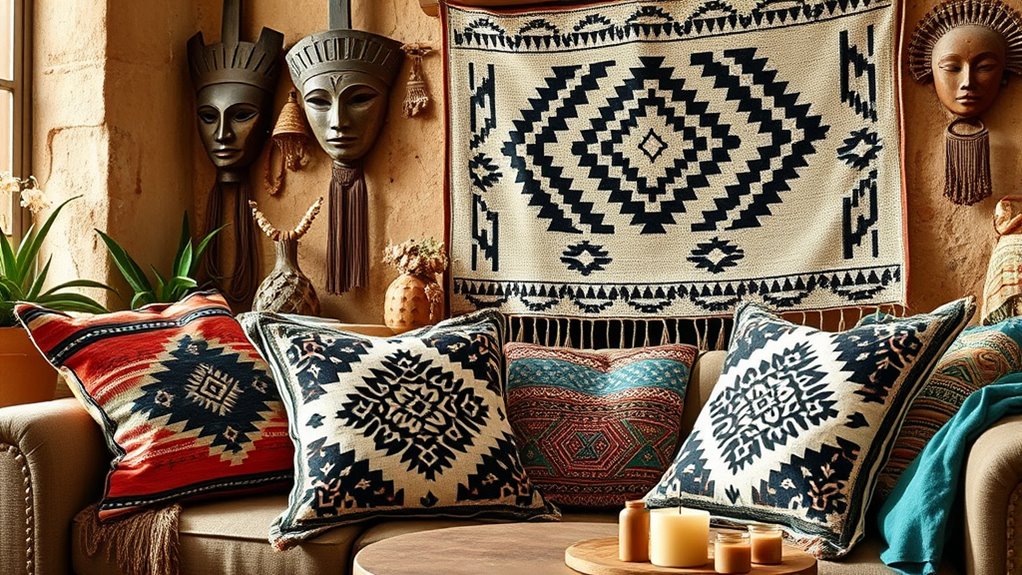
Incorporating tribal elements into modern boho decor instantly adds a sense of authenticity and cultural richness to any space. You can achieve this by integrating pieces that showcase geometric abstraction, which simplifies traditional patterns into bold shapes and lines. These designs create visual interest and a contemporary feel while honoring tribal artistry. Additionally, pay attention to color symbolism; certain hues carry specific meanings and evoke emotions that deepen the decor’s cultural significance. For example, earthy tones often symbolize connection to nature, while vibrant colors can represent vitality and life. Incorporating Water Parks into your decor theme can also inspire playful and refreshing accents that evoke a sense of leisure and relaxation. By blending these elements thoughtfully, you enhance your space’s aesthetic and foster a genuine appreciation for tribal heritage, making your decor both stylish and meaningful.
Techniques and Styles in Tribal Pattern Design
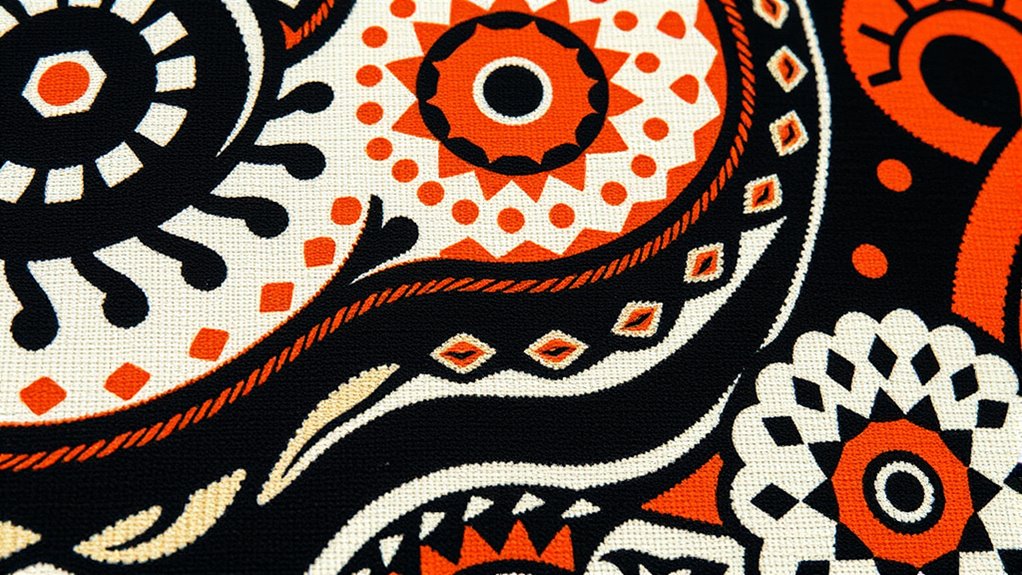
Tribal pattern design employs a variety of techniques and styles that reflect the diverse cultures from which they originate. You’ll notice mastery in textile techniques like weaving, embroidery, and dyeing, which give patterns texture and depth. The color palettes are often bold and earthy, using natural dyes to create striking contrasts and harmony. To incorporate these styles, consider: 1. Using traditional textile techniques to add authenticity and tactile richness. 2. Choosing color palettes inspired by nature, such as browns, reds, and ochres. 3. Combining geometric shapes and motifs that are characteristic of specific tribal cultures. Incorporating unique design elements like recycled materials or handcrafted details can further enhance the authenticity and artistic value of tribal-inspired patterns.
The Cultural Significance of Tribal Patterns in Boho Expressions
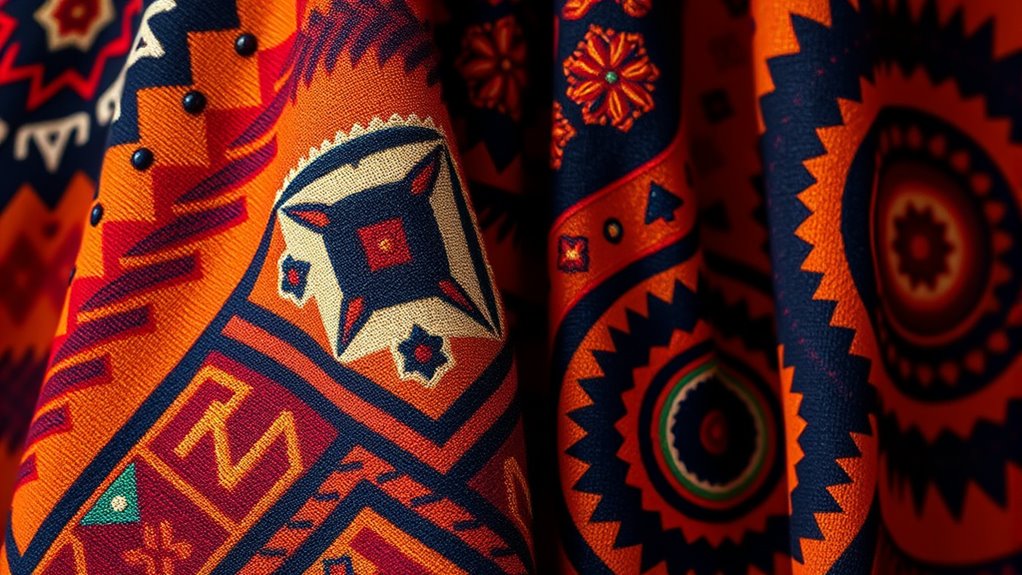
Tribal patterns hold deep cultural significance, serving as visual expressions of identity, belief, and history. When you incorporate these patterns into boho art, you embrace a form of fashion fusion that celebrates diverse cultural roots. Each pattern tells a story, connecting you to ancestral traditions and spiritual beliefs. This artistic diversity not only enriches your personal style but also honors the communities from which these designs originate. By integrating tribal patterns, you participate in a broader cultural dialogue, respecting their symbolic meanings. Your boho expressions become more than fashion statements; they become a way to preserve and showcase the rich heritage behind each pattern. Engaging with cultural symbols deepens your connection to cultural history while inspiring creative freedom.
Future Trends: Evolving Tribal Influences in Boho Aesthetics

As boho fashion continues to evolve, designers are increasingly blending traditional tribal motifs with contemporary aesthetics, creating fresh and innovative expressions of cultural influence. You can expect tribal patterns to adapt within modern styles, especially as contemporary fashion embraces diversity. Urban aesthetics are also playing a significant role, infusing tribal elements into streetwear and edgy designs. Here are three future trends to watch: 1. Fusion of tribal patterns with minimalist designs in everyday wear. 2. Incorporation of tribal motifs into sustainable and eco-friendly fashion. 3. Use of digital art to reinterpret traditional tribal symbols for a global audience. Additionally, Vetted Archives – StrongMocha highlights how traditional tribal influences can be integrated into skincare and beauty products, emphasizing their versatility and cultural relevance. These trends will make tribal influences more accessible, versatile, and relevant in shaping the future of boho aesthetics.
Frequently Asked Questions
How Do Tribal Patterns Vary Across Different Indigenous Cultures Worldwide?
You’ll notice that tribal patterns vary widely across indigenous cultures, reflecting unique cultural symbolism and pattern symbolism. For example, African tribes often use bold geometric shapes representing community and spirituality, while Native American patterns incorporate natural motifs symbolizing harmony with nature. These designs serve as storytelling tools, embodying history, beliefs, and identity, making each pattern a powerful expression of cultural values that influence boho art’s diverse and vibrant aesthetic.
Can Tribal Motifs Influence Contemporary Fashion Beyond Home Decor?
Yes, tribal motifs influence contemporary fashion beyond home decor. You might wear clothing or accessories featuring tribal symbolism, adding cultural depth to your style. However, be mindful of cultural appropriation, respecting the origins of these patterns. When you incorporate tribal motifs, you help celebrate their cultural significance while avoiding misappropriation, ensuring your fashion choices honor the traditions behind these designs rather than commodifying them.
What Ethical Considerations Are Involved in Using Tribal Designs in Art?
You should prioritize cultural appropriation, respectful representation, and ethical sourcing when using tribal designs. Avoid exploiting or misrepresenting Indigenous cultures by understanding their significance, seeking permission, and giving proper credit. By respecting traditions and acknowledging origins, you foster cultural appreciation rather than appropriation. This approach guarantees your art honors the communities it draws from, promoting genuine respect and preserving cultural integrity.
How Do Tribal Patterns Affect the Emotional Atmosphere of a Space?
Tribal patterns substantially influence the emotional atmosphere of a space by adding cultural symbolism that evokes a sense of connection and authenticity. When you incorporate these designs thoughtfully, they create visual harmony, making the environment feel warm, grounded, and inviting. You may notice feelings of liveliness or tranquility depending on the patterns’ complexity and colors, enhancing your space’s overall mood and making it more meaningful to you and your guests.
Are There Specific Tribal Patterns That Are Universally Recognized or Accepted?
You’ll find that some tribal patterns, like zigzags, chevrons, or spirals, are widely recognized due to their symbol recognition and pattern universality. These motifs often transcend specific cultures, making them popular choices in boho art. While no pattern is entirely universal, these designs tend to evoke a sense of connection and familiarity, allowing you to incorporate them confidently into your space to create a lively, culturally rich atmosphere.
Conclusion
As you embrace boho decor, let tribal patterns guide your space like a vibrant tapestry woven with history and soul. Picture the bold lines and intricate motifs dancing across your walls, each telling a story of ancient traditions and cultural expression. By infusing your environment with these timeless designs, you create a vibrant sanctuary filled with meaning and connection. Keep exploring, and watch your space transform into a mesmerizing haven alive with tribal spirit.

